Abandoned History: Chrysler and the Colt, Captive Economical Import Time (Part V)

When we last left off in the tale of Dodge, Plymouth, and Eagle’s various Colt branding adventures, it was the late Eighties. After a wave of modernization in 1984-1985 where the first Colt sedan appeared and the range extended into the larger and very forward-thinking Colt Vista, Mitsubishi got in on the Colt action and sold a hatchback with its OEM diamond star up front and Mirage lettering on the back. As the Nineties approached, it was time for a new generation of Colts, and more options from a hot new brand: Eagle.
The sixth-generation Colt arrived for the 1989 model year, as a vastly more modern-looking replacement for the ’85-’88 version. It should be noted that while the smaller Colt was replaced, the Colt Vista (Mitsubishi Chariot) existed in its initial form for a couple more years, even though by the late Eighties it was looking very dated.
For 1989 the sixth-generation Colt was, underneath, a third-generation Mitsubishi Mirage. The Mirage entered initial production in 1987 as a three-door hatchback, and in 1988 a sedan and five-door liftback joined the range. North America received its new Colt after all body styles were available, as Chrysler wanted a full barn of Colt body styles. Though the word hodgepodge was an apt descriptor, as we’ll see in a moment.
While the fifth-gen Colt was sold with three- or five-doors and as a four-door sedan and wagon, things got a bit too spread out for Chrysler’s liking. After the almost immediate discontinuation of the five-door in favor of the Omni/Horizon that Chrysler developed themselves, the remaining Colt sedan, regular wagon, and larger Vista wagon filled out the lineup. The new Colt for America in 1989 was a singular Colt body style, the three-door hatchback. A new Colt four-door sedan was also imported, but for branding reasons was only offered as a Colt in the Canadian market.
The sixth-generation Colt was more rounded than its predecessor and looked as though engineers had finally accepted the principle of aerodynamics. There was little resemblance in old and new Colt hatchbacks, unlike the jump from generations four to five. A flush pair of headlamps wrapped around into knife-edge corner markers, and a simplified one-bar grille up front had COLT lettering in the middle. Both hatch and sedan were more stylish than before, with blacked-out B- and C-pillars adding a sportier look to the hatchback. At the back, there was a rounded rear end, with better-integrated bumpers than before and a Nineties-approved heckblende. Again the cars wore Colt badging but didn’t say Dodge or Plymouth on them. On higher trims, bumpers were body-colored, as Colts stepped away from their extra basic mid-Eighties image. The Colt/Mirage took cues on their looks from the larger Galant, which meant the new generation looked a bit more upmarket than before.
In its transition to Nineties-type design, the Colt grew slightly larger in all dimensions. The old 93.7-inch wheelbase grew to 93.9 inches, while the overall length of 157.3 inches (hatch and sedan) grew to 158.7 inches for the hatch and a long 170.1 inches for the sedan. Width increased notably here, from 63.8 inches to 65.5 inches; a boon to North American consumers who always wanted additional width in their subcompacts.
Engines were simplified over the old model though not necessarily modernized much. The Seventies 1.5-liter G15B Orion family engine persisted as the entry-level motivator, with SOHC and 82 horsepower. The Colt’s base engine received fuel injection for the first time in 1989. It was supplemented by another carryover, the 1.6-liter 4G61 Sirius family engine, with DOHC technology and an output of 123 horses. That engine was available previously, but only on the slow-selling fifth-gen Colt wagon.
The third and final engine option was a new one: the turbocharged variation of the 1.6, the 4G61T. In North American specification it managed 135 horsepower. The turbocharged engine ended up as an exception rather than the rule, as it was offered only in 1989. It’s estimated that just 1,500 sixth-gen Colts were turbocharged, in a special trim called the GT Turbo. There was also a Mirage Turbo, sales of which are included in that 1,500 figure.
Transmission options were three and included a three-speed automatic or four- or five-speed manual. Unlike the fifth-generation Colt where Dodge dabbled in four-wheel drive here and there, all sixth-gen models were strictly front-drive.
While the sixth-gen Colt sedan was on sale in Canada, the fifth-gen sedan and three-door hatch remained on sale simultaneously, badged as an Eagle Vista (not to be confused with the larger seven-passenger Eagle Vista Wagon.) Those old models persisted in Canada only through the 1992 model year, as economy cars for the cheapskate buyer. The Vista name was retired in Canada after 1992, in favor of the Summit. It was an interesting strategy to sell old holdover models at an exciting new brand while bringing new product to Colt.
There was also an elder statesman at Dodge and Plymouth dealerships in the U.S., in the wagon and Vista. Though the hatchback moved on to sixth-gen guise in 1989, the old fifth-gen Colt wagon remained on sale through 1990 and the Colt Vista through 1991. That was in preparation for the new Colt Wagon (and Eagle Summit), which was based on the Mitsubishi RVR and unrelated to the Colt hatch and old Colt Vista.
Now let’s talk Eagle (the U.S. one). Adding to the market mix-ups, while Canadians enjoyed Colt badging on the sixth-generation hatchback and sedan, the sedan was sold in America as the Eagle Summit. Between 1989 and 1992, the Summit was the smallest of Eagle’s offerings. It was equipped the same way as other Colts and Mirages, as one would expect. In 1989 the Summit was only available as a sedan, in two trims: DL and LX. The 1.5- and 1.6-liter engines were available on Summit, but the turbocharged mill was never offered.
The Summit and Colt sedans were known for their interior space, and meant with four doors the car moved up a size class to compact. It was still priced like a subcompact though, which made the sedan somewhat of a bargain. 1990 saw an expansion of Summit trim, with a base model below DL and a well-equipped ES. The ES got a bit more serious about performance and used the 1.6-liter engine along with alloy wheels and four-wheel discs, as well as a sportier suspension setup.
Prices on the Summit started at $9,190 ($20,280 adj.) for the unmarked base and moved to $9,751 ($21,518 adj.) for the DL. Middling LX examples were $10,703 ($23,619 adj.), while the ES asked $11,552 ($25,493 adj.). Though Eagle trims would typically top out at the ES, in 1990 there was also an LX DOHC trim. With the more powerful engine as well as all sports features from the ES, the LX DOHC asked $12,022 ($26,530 adj.).
In addition to building the Eagle lineup as Chrysler prepared for DSM availability in the near future, the brand differentiation allowed Chrysler to shift the larger and technically compact Summit sedan at a higher price. In 1990 the Colt hatchback lineup started at $7,136 ($15,747 adj.) for the unmarked base model and stepped notably to the GL for $8,194 ($18,082 adj.). Above it was the naturally aspirated GT hatchback at $9,406 ($20,757 adj.). That was the starting point for the larger Colt Vista wagon (still in earlier Eighties guise) in DL trim at $9,601 ($21,187 adj.), while the DL 4WD asked $11,430 ($25,223 adj.). The most expensive Colts for 1990 were the Vista wagons, where a front-drive version asked $12,226 ($26,980 adj.), and the four-wheel-drive trim was $13,452 ($29,686 adj.).
Though the Mirage was produced in numerous locations around the world, all hatchback Colts for North America were produced at Mitsubishi’s plant in Okayama, Japan. Sedans were also produced in Japan through the 1990 model year. Thereafter, sedans were made in Normal, Illinois at the new Chrysler-Mitsubishi joint venture, Diamond-Star Motors.
Colt became a more important asset to Chrysler after 1990, as there was a change to the company’s core lineup. It was (finally) time to wave a tearful goodbye to the Omni and Horizon hatchbacks that had cluttered roads with their slowness since 1978. Chrysler had no homegrown subcompact ready, so leaned in fully on the Colt offerings. Car buyers in the more expensive compact class who wanted a pure domestic would’ve opted for the Dodge Shadow or Plymouth Sundance instead.
1990 was a transitional year for Colt, as aged product existed alongside newer hatchbacks, and Eagle joined the fray as a fourth outlet for Colt, if one included the Mirage at Mitsubishi dealers. 1991 would see some product consolidation as the old wagon and Vista made way for the Colt Wagon and Eagle Summit Wagon. That year was also the start of the big push toward Eagle, as Chrysler began to step away from Colt. More next time.
[Images: Chrysler]

Interested in lots of cars and their various historical contexts. Started writing articles for TTAC in late 2016, when my first posts were QOTDs. From there I started a few new series like Rare Rides, Buy/Drive/Burn, Abandoned History, and most recently Rare Rides Icons. Operating from a home base in Cincinnati, Ohio, a relative auto journalist dead zone. Many of my articles are prompted by something I'll see on social media that sparks my interest and causes me to research. Finding articles and information from the early days of the internet and beyond that covers the little details lost to time: trim packages, color and wheel choices, interior fabrics. Beyond those, I'm fascinated by automotive industry experiments, both failures and successes. Lately I've taken an interest in AI, and generating "what if" type images for car models long dead. Reincarnating a modern Toyota Paseo, Lincoln Mark IX, or Isuzu Trooper through a text prompt is fun. Fun to post them on Twitter too, and watch people overreact. To that end, the social media I use most is Twitter, @CoreyLewis86. I also contribute pieces for Forbes Wheels and Forbes Home.
More by Corey Lewis
Latest Car Reviews
Read moreLatest Product Reviews
Read moreRecent Comments
- Ajla IMO, something like this really should be naturally-aspirated.
- Kjhkjlhkjhkljh kljhjkhjklhkjh Unless they are solid state batteries you BAN THEM. I like EVs... but EVs like to burn ... for days
- Kjhkjlhkjhkljh kljhjkhjklhkjh uh .. it looks like a VW golf got the mumps
- Kjhkjlhkjhkljh kljhjkhjklhkjh I CANNOT WAIT FOR SOCIAL SECURITY TO GET GUTTED.. No i am really serious. I am insulated thanks to 24 years at Symantec then Broadcom .. tons of retirement cash. but all the blue hairs and low income trump voters are going to lose benefits and jobs and i get to laugh allllll dayyyyy long in about 2-3 years.. CANNOT WAIT, POPCORN READY.
- Kjhkjlhkjhkljh kljhjkhjklhkjh no. to many '''''americans'''' just want a CUV or SUV according to sales numbers



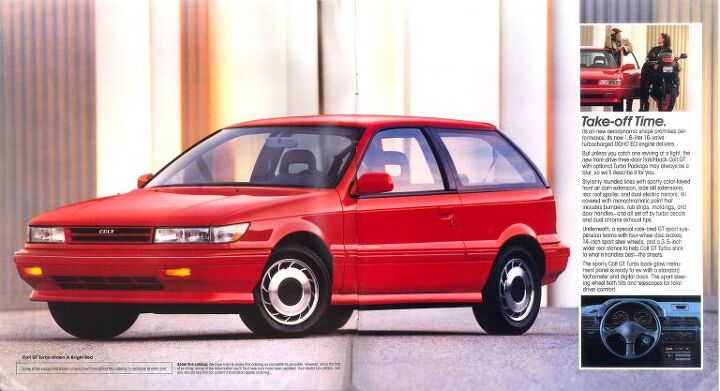






















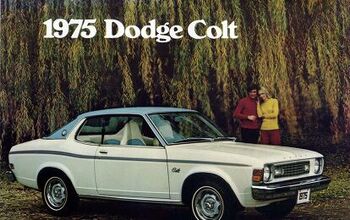
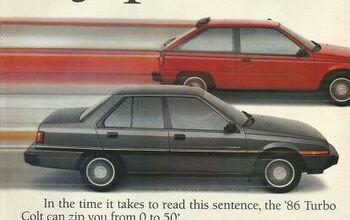
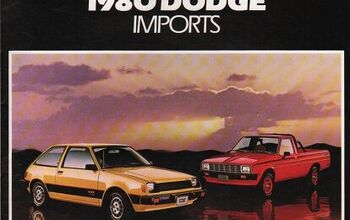
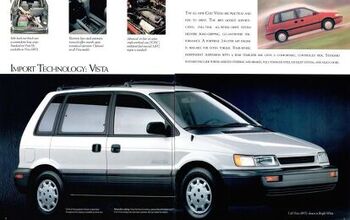
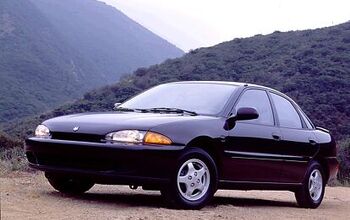










Comments
Join the conversation
Zero mention of the Plymouth Arrow? The Arrow was introduced in '76 as a counter to the Corolla hatch and Celica GT. A 3rd Hatch with Mustang styling, in '78 the Arrow offered the "Fire Arrow" GT model that packaged the big 2.6L Silent Shaft "MCA-Jet" engine, a 5 speed and 4 wheel discs. Heady stuff in '78. A HS buddy got the Arrow GT 2.6L and was the envy of the B-210 and Corolla drivers, along with me and my 1.6L Rabbit. The Arrow was a stylish and good performing car with absolutely zero rust protection from the factory. It was a pile of iron dust in about 6 years in salty South Florida.
My wife had a '91 Colt 200 hatchback. They all had A/C buttons even if it wasn't installed. She bought it used and she didn't know it had air conditioning until five years later when she pressed the button to see what would happen... which was a minute of cold air, followed by a loud squeal as the compressor seized. Personally, I ended up buying a regular Civic DX instead of a Colt turbo. Don't know if I would have regretted buying the Colt over time, but it would have been fun.